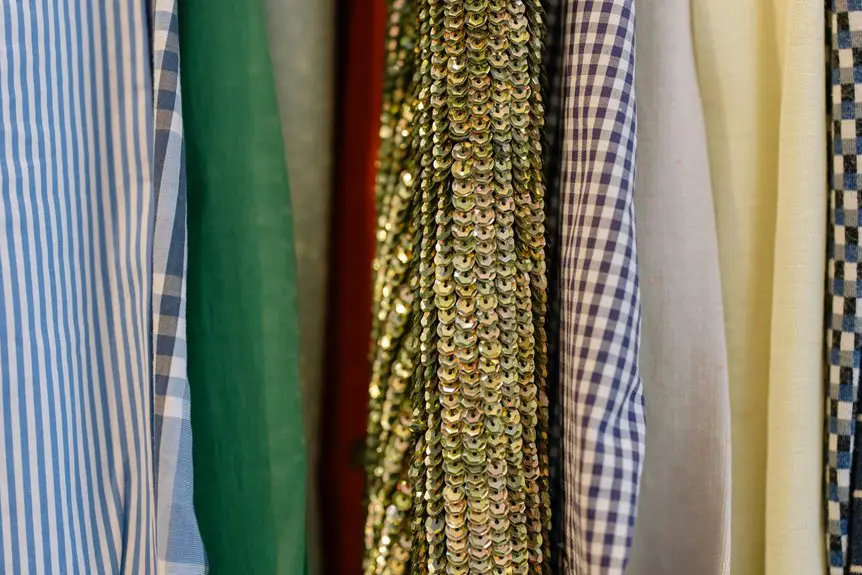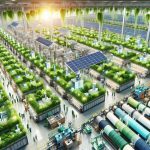Consumer behavior is reshaping the fashion landscape, especially regarding sustainable fabrics. As you consider your choices, think about how personal values influence your purchasing decisions. With Millennials and Gen Z at the forefront, the demand for transparency and eco-friendly options is growing. But what happens when brands fail to meet these expectations? Understanding these dynamics can reveal much about the future of fashion and sustainability.
Table of Contents
Key Takeaways
- Consumer awareness of environmental and ethical issues drives demand for sustainable fabrics, influencing purchasing decisions.
- Millennials and Gen Z prioritize brands that align with their values, fostering a market shift towards eco-friendly materials.
- Social media platforms amplify awareness and provide education on sustainable fashion, encouraging consumers to choose responsible options.
- Skepticism towards greenwashing prompts consumers to seek transparency in sourcing and manufacturing practices from brands.
- Increased consumer preference for organic and recycled materials leads brands to innovate and adopt sustainable practices in fabric production.
Understanding Consumer Priorities in Fashion Choices
How do you decide what to wear? You likely consider factors like comfort, style, and occasion.
But what about sustainability? As you navigate your wardrobe, you might prioritize fabrics that align with your values. Whether it’s organic cotton, recycled polyester, or innovative materials, your choices reflect a desire for eco-friendly options.
You may also think about the brand’s ethics and transparency. Do they support fair labor practices? Are they committed to reducing their environmental footprint?
As you shop, your preferences shape the market, pushing brands to adopt sustainable practices.
Ultimately, your fashion choices aren’t just about looking good; they’re a statement about who you’re and what you stand for in today’s world.
The Impact of Environmental Concerns on Fabric Selection
As environmental concerns increasingly shape consumer preferences, you might find yourself more conscious of the fabrics you choose.
You may start to prioritize materials that are organic, recycled, or sustainably sourced, reflecting your values in your wardrobe. By opting for these fabrics, you not only reduce your carbon footprint but also support brands committed to ethical practices.
Prioritizing organic, recycled, and sustainably sourced fabrics allows you to align your wardrobe with your values while supporting ethical brands.
You might notice that your decisions are influenced by factors like water usage, chemical treatment, and the overall lifecycle of the fabric.
As you seek transparency from companies, you’ll likely demand more information about their sourcing and manufacturing processes. This shift in focus encourages the fashion industry to innovate, paving the way for sustainable practices that resonate with your growing environmental awareness.
The Rise of Millennial and Gen Z Influence
Why are Millennials and Gen Z driving the shift towards sustainable fabrics? These generations prioritize environmental responsibility and ethical consumption more than any before them.
You’re likely aware of their growing demand for transparency in the fashion industry, pushing brands to adopt sustainable practices. When you shop, you’re not just looking for style; you want to support companies that align with your values.
This drive for change is evident in your choices—whether it’s opting for organic cotton or recycled materials. Additionally, you often seek out brands that highlight their sustainability efforts, making them more appealing.
The Role of Social Media in Promoting Sustainable Fabrics
Social media plays an essential role in raising awareness about sustainable fabrics, especially through the influence of popular figures.
You’ll often see influencers showcasing eco-friendly brands, making sustainable choices more appealing and relatable.
Additionally, platforms like Instagram and TikTok use targeted outreach strategies to engage consumers and spark conversations about sustainable fashion.
Influencer Impact on Awareness
How can influencers shape your understanding of sustainable fabrics? They play an essential role in raising awareness and educating you about eco-friendly options.
By sharing their personal experiences with sustainable brands, influencers make these choices relatable and accessible. Their authentic storytelling often resonates with you, making the idea of sustainable fashion more appealing.
Through engaging visuals and informative content, influencers help demystify sustainable fabrics, spotlighting their benefits and importance.
You’re likely to trust recommendations from someone you admire, which can motivate you to make more conscious purchasing decisions. By following these influencers, you expand your knowledge and become part of a growing movement towards sustainability in fashion.
This shift in perception can greatly impact your buying habits and overall consumer behavior.
Social Platforms’ Outreach Strategies
As influencers raise awareness about sustainable fabrics, social media platforms amplify this message, reaching wider audiences and fostering community engagement.
You can leverage these platforms to connect with like-minded individuals and brands that prioritize sustainability. Hashtags like #EcoFashion and #SustainableStyle help you discover trends and products that resonate with your values.
Engaging with posts, sharing your own sustainable choices, and participating in discussions can enhance your understanding of eco-friendly fabrics.
Additionally, brands often run campaigns on these platforms, offering promotions or educational content that can inform your purchasing decisions.
The Consequences of Greenwashing on Consumer Trust
While many brands tout their eco-friendly initiatives, greenwashing can severely undermine consumer trust. When you realize a brand’s claims are exaggerated or false, it leads to disillusionment.
Greenwashing erodes consumer trust, leading to disillusionment when brands’ eco-claims are found to be exaggerated or false.
Here are some key consequences of greenwashing you should be aware of:
- Loss of Credibility: Once you spot greenwashing, you may doubt the brand’s genuine efforts in sustainability.
- Decreased Loyalty: You might start to look elsewhere for brands that truly align with your values.
- Skepticism Towards Sustainability: Greenwashing can make you skeptical of all eco-friendly claims, even from honest brands.
- Negative Brand Perception: Brands caught in greenwashing may face backlash, damaging their public image long-term.
Understanding these consequences can help you make informed choices in your purchasing decisions.
Demand for Transparency and Verification in Sustainability Claims
Greenwashing has left many consumers feeling wary and demanding more from brands regarding their sustainability claims.
You want to know exactly what goes into the fabrics you wear and how they’re produced. Transparency is no longer just a buzzword; it’s a necessity.
You’re likely looking for brands that provide clear, verifiable information about their sourcing, manufacturing processes, and environmental impact. Certifications from trusted organizations can help you feel more confident in your choices.
As you seek out sustainable options, you expect brands to back up their claims with data and proof, rather than vague statements.
This shift in consumer behavior is pushing companies to adopt more honest practices, ultimately benefiting the environment and your purchasing decisions.
The Growth of the Sustainable Fashion Market
The sustainable fashion market is rapidly expanding, driven by your growing awareness of the environmental and ethical implications of clothing production.
You’re starting to seek out brands that align with your values, and this shift is reshaping the industry. Here are some key factors fueling this growth:
- Increased Awareness: You’re more informed about the environmental impact of fast fashion.
- Ethical Choices: You prioritize brands that promote fair labor practices.
- Quality Over Quantity: You value durability and timeless styles over cheap, trendy pieces.
- Community Influence: You’re inspired by peers who advocate for sustainable living.
As you continue to demand change, the sustainable fashion market will only grow, creating a more responsible industry for all.
Key Sustainable Fabrics and Their Benefits
When you consider sustainable fabrics, organic fibers stand out for their numerous advantages, including lower environmental impact and improved durability.
You’ll find that healthier fabric options not only benefit the planet but also enhance your well-being.
Plus, certifications can boost your confidence in these choices, ensuring they meet higher sustainability standards.
Organic Fiber Advantages
While many fabrics contribute to environmental challenges, organic fibers stand out for their numerous benefits. Choosing organic fibers not only supports sustainable practices but also enhances your wardrobe in several ways:
- Eco-friendly production: Grown without synthetic pesticides or fertilizers, reducing soil and water contamination.
- Biodegradable: Organic fibers break down naturally, minimizing landfill waste and pollution.
- Durability: Often stronger than conventional fibers, they last longer, saving you money in the long run.
- Water-efficient: Organic farming typically uses less water, helping conserve this precious resource.
Healthier Fabric Options
Building on the advantages of organic fibers, exploring other sustainable fabric options reveals a variety of healthier materials that offer both environmental and personal benefits.
For instance, Tencel, made from sustainably sourced wood pulp, is both biodegradable and soft on your skin, promoting comfort without chemical additives.
Hemp, a fast-growing crop, requires minimal water and pesticides, making it an eco-friendly choice that’s durable and breathable.
Recycled polyester, derived from plastic bottles, not only reduces waste but also provides moisture-wicking properties.
Ultimately, bamboo fabric boasts natural antibacterial qualities, making it ideal for sensitive skin.
Certifications Enhancing Trust
As you explore sustainable fabrics, understanding the certifications that back these materials can enhance your trust in their claims.
These certifications indicate that a fabric meets specific environmental and ethical standards. Here are four key certifications to look for:
- GOTS (Global Organic Textile Standard): Confirms organic fibers and eco-friendly processing.
- OEKO-TEX® Standard 100: Guarantees textiles are free from harmful substances.
- Fair Trade Certified: Promotes fair wages and safe working conditions for producers.
- Recycled Claim Standard (RCS): Verifies the recycled content in a product.
Ethical Consumption Trends and Their Influence
Ethical consumption trends are reshaping the way consumers approach their purchases, especially when it comes to sustainable fabrics.
You’re increasingly aware of the impact your choices have on the environment and society. This awareness drives you to seek out brands that prioritize transparency, eco-friendly materials, and fair labor practices.
You’re not just buying a product; you’re supporting a movement that values sustainability and ethics. Social media plays an essential role in amplifying these values, making it easier for you to connect with brands and share your preferences.
As more consumers like you demand sustainable options, companies are feeling the pressure to adapt. Your choices are influencing the market, pushing the fashion industry towards more responsible practices.
Industry Strategies to Meet Consumer Expectations for Sustainability
To effectively meet your expectations for sustainability, the fashion industry is increasingly adopting innovative strategies that prioritize eco-friendly practices.
Here are four key approaches brands are using:
- Sourcing Sustainable Materials: Companies are opting for organic cotton, recycled polyester, and other eco-friendly fabrics to reduce their environmental impact.
- Transparent Supply Chains: Brands are sharing their sourcing and production processes, allowing you to make informed choices about where your clothes come from.
- Circular Fashion Initiatives: Many are introducing take-back programs and recycling options, encouraging you to return old garments for repurposing.
- Eco-Friendly Production Methods: Brands are investing in technologies that minimize water usage and energy consumption during manufacturing, making a positive impact on the planet.
These strategies not only align with your values but also help shape a more sustainable future.
Frequently Asked Questions
What Are the Most Popular Sustainable Fabric Types Among Consumers?
When considering sustainable fabrics, you’ll likely find organic cotton, bamboo, hemp, and Tencel are among the most popular choices. They’re eco-friendly, comfortable, and increasingly favored by consumers who value sustainability in their fashion choices.
How Can Consumers Identify Truly Sustainable Brands?
When you seek the golden threads of true sustainability, look for transparency in brand practices, certifications like GOTS, and ethical sourcing. Trust your instincts; a genuine brand will shine brightly amidst the greenwashed shadows.
What Role Do Certifications Play in Sustainable Fabric Purchasing Decisions?
Certifications help you spot genuine sustainable fabrics by providing trusted standards. When you see a certification, it assures you that the brand meets specific environmental and ethical criteria, making your purchasing decisions more informed and confident.
Are There Specific Eco-Friendly Fabrics for Athletic Wear?
Yes, there are eco-friendly fabrics for athletic wear. You’ll find options like recycled polyester, organic cotton, and Tencel, which offer breathability and durability while minimizing environmental impact. These materials help you make sustainable choices in fitness apparel.
How Does Sustainable Fabric Impact Garment Durability?
You might think sustainable fabrics compromise durability, but they often outperform conventional options. Enhanced fibers resist wear and tear, ensuring your garments last longer while minimizing environmental impact, proving that eco-friendly choices can be both durable and responsible.
- How to Wash White Percale Sheets for a Brighter, Cleaner Look - July 15, 2025
- How to Prevent Wrinkles in Percale Sheets: A Complete Guide - July 15, 2025
- How to Keep Percale Sheets From Wrinkling: Pro Tips - July 15, 2025






